Three Walks In Montmartre – Strolls Through The Village On The Hill
Montmartre is a place different from the rest of Paris. From its location high on the hill, this former village looks down upon the city it only became part of in 1860. Today you'll find that Montmartre still retains a lot of that village atmosphere. Take in its charm and history on these three walks through the one-time home of Picasso, van Gogh, Renoir, and Matisse.
![]()
Our Top-Rated Montmartre Experiences
1. A Taste of Montmartre… Discovery on a gourmet walking tour
2. Dinner & Cabaret at the Moulin Rouge… Visit the legendary night spot
3. Montmartre and Sacre-Coeur Walking Tour…
4. Hotel Maison Souquet… Our #1 Montmartre pick
1. Around Place des Abbesses
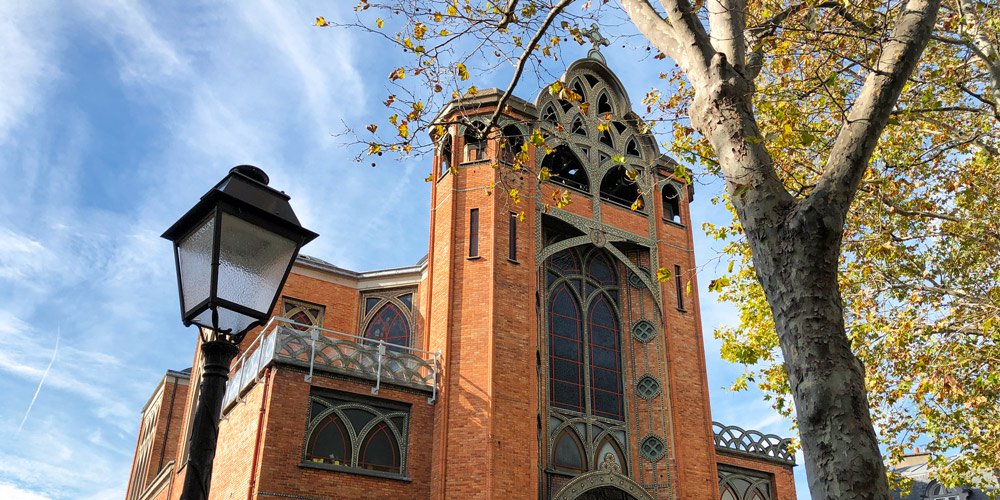 Église Saint-Jean de Montmartre on Place des Abbesses, photo by Mark Craft
Église Saint-Jean de Montmartre on Place des Abbesses, photo by Mark Craft
There's a lot to see in this historic neighborhood on the hill and it starts as soon as you get off Metro line 12 at Abbesses station. (By the way, be sure to take the elevator from the train platform — there are a LOT of steps if you take the stairs!) You come out on Place des Abbesses and are greeted by a children's year-round carousel, the towering brick structure of Église Saint-Jean de Montmartre, and the iconic 1900 Art Deco Metro entrance by Hector Guimard. Just across the place is Square J. Rictus where you can view a mural tile installation featuring the many ways to say "I love you".
Return to Place des Abbesses, turn right (uphill), and walk to the first passageway on your right, Passage des Abbesses. Climb up the hill to Rue des 3 Frères. Turn left and walk to a small place (on your right). Here, at 11 bis , was the location of a famous rooming house called Le Bateau-Lavoir. Though the original building is gone, this is where some important artists and writers lived, wrote and painted — Picasso, Max Jacob, Henri Matisse, Jean Cocteau. To learn more about the famous artists who once lived here, we recommend you take a walking tour of Montmartre, led by an expert guide.
![]()
Delicious Activities in the Marais
|
Marais Food & Wine Tour |
Cheese & Wine Tasting in a Paris Cellar |
|
Cheese & Wine Tasting in a Paris Cellar |
2. Walking Rue Lepic
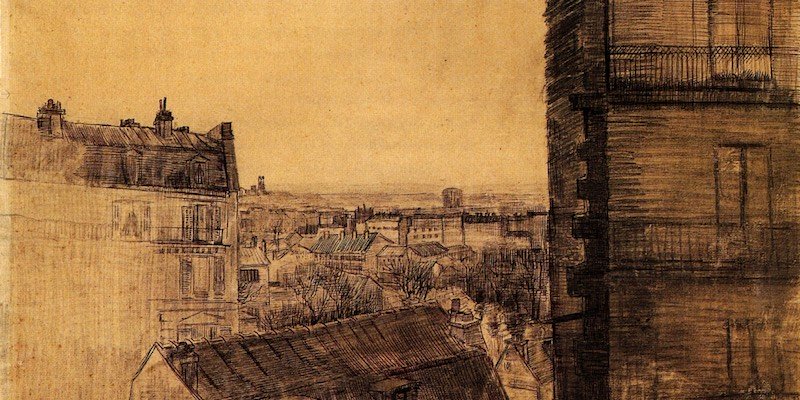 From an apartment on Rue Lepic, 1887, by van Gogh
From an apartment on Rue Lepic, 1887, by van Gogh
If you were to only visit Montmartre for its cabarets — Moulin Rouge, La Nouvelle Eve — you would be missing the true heart of the quartier. Up on the hill from those night spots is where the "real" Montmartre starts. From Place des Abbesses, a stroll uphill (heading west) along Rue des Abbesses takes you through the modern heart of the neighborhood, past restaurants, shops, and some of the best boulangeries in all of Paris. It's along here that locals shop for their daily needs.
As you continue uphill, Abbesses gently curves into Rue Lepic, the street most typical of residential Montmartre. It's a lovely walk along its cobblestoned surface, taking you past a few restaurants and shops, but mostly among the buildings where Montmartrians live. Near the top you reach restaurant Le Moulin de la Galette where you find one of the original windmills. This is the place where Renoir painted his canvas of the same name. Van Gogh also drew and painted Rue Lepic when he lived here. (Van Gogh's drawing above is of the view from his apartment.)
A few steps farther the street forks at Parc Jean-Baptiste Clément. Take the left fork to Rue Norvins and the old village of Montmartre. Turn right on Norvins to reach Sacre-Coeur.
![]()
Romantic Dinner Cruises In Paris
|
VIP Dinner Cruise with Bateaux Parisiens |
Dinner Cruise by Maxim's of Paris |
|
VIP Dinner Cruise with Bateaux Parisiens |
3. A Short Promenade in Montmartre
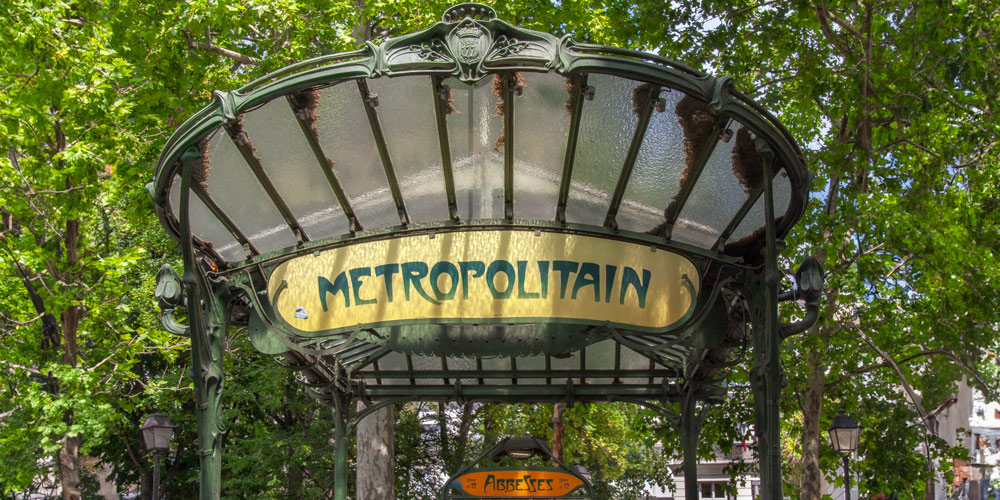 Hector Guimard's 1900 Metro entrance at Abbesses, photo by Mark Craft
Hector Guimard's 1900 Metro entrance at Abbesses, photo by Mark Craft
There's quite a lot to see in this historic neighborhood on top of the hill. Come along with us on this short (and virtual) walking tour. Start once again at Place des Abbesses. From the Metro entrance turn right (uphill) and take a few steps to the first passageway on your right, Passage des Abbesses. Climb up the hill to Rue des 3 Frères. Turn left to a small place (on your right). Here, at 11 bis , was the location of a famous rooming house called Le Bateau-Lavoir. Though the original building is gone, this is where some important artists and writers lived, wrote and painted — Picasso, Max Jacob, Henri Matisse, Jean Cocteau.
![]()
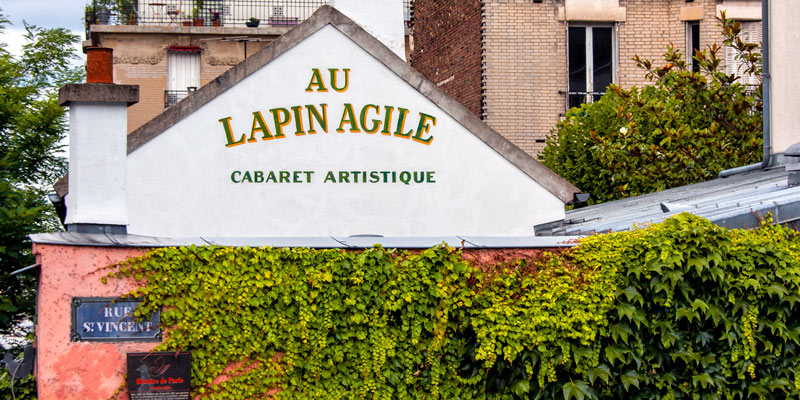 Au Lapin Agile, photo by Mark Craft
Au Lapin Agile, photo by Mark Craft
![]()
Cross the place to Rue Ravignan and turn left into Rue d'Orchampt. Walk this narrow cobblestone street to its end. You'll be on Rue Lepic, at the windmill of Moulin de la Galette, a mill since the 17th century and a nightclub since the 19th. In its heyday it was frequented by Pissarro, van Gogh, and Renoir, who famously painted the gay scene at Galette. (Shown further above, with the Montmartre Impressionist Art Walking Tour) Now, continue right on Rue Lepic until you come to Rue Norvins.
This is the heart of old Montmartre village. You'll join throngs of tourists, each enchanted by the street's charm. Before you explore further, you might want to take a side trip down Rue des Saules to visit Le Lapin Agile, a Montmartre cabaret made famous by Picasso's painting of the same name. Across the street is the Montmartre vineyard, where the only wine still made in Paris comes from. (It's a fun tradition but a lousy wine!) Return to Rue Norvins and stroll through the old village.
![]()
Top-Rated Paris Museum Tours
|
The Louvre's Greatest Masterpieces |
Musé d'Orsay Guided Tour |
|
The Louvre's Greatest Masterpieces |
![]()
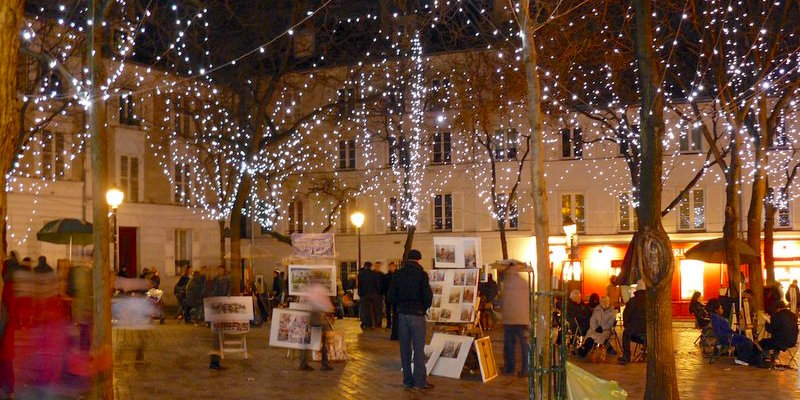 Place de Tertre in Montmartre, photo by Larry Davis
Place de Tertre in Montmartre, photo by Larry Davis
![]()
Rue Norvins takes you to Place du Tertre, a lively square where artists paint and ply their works, and where tourists mingle and have their portraits painted. (Photo.) You can go further along Rue Norvins to get to Sacre Coeur or exit the place on the south to Rue de Calvaire, where steps take you Rue Gabrielle.
Turn left a few steps then head downhill on Rue Drevet, which turns into more steps after you cross Rue Verthe. At the bottom of the steps you'll be on Rue le Vieuville. Follow this street as it curves back to Place des Abbesses.
Paris Planning Guides
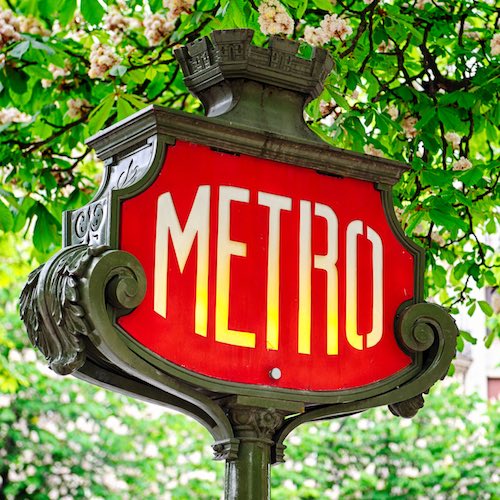 Paris Metro Guide
Paris Metro Guide |
 Left Bank Hotels
Left Bank Hotels |
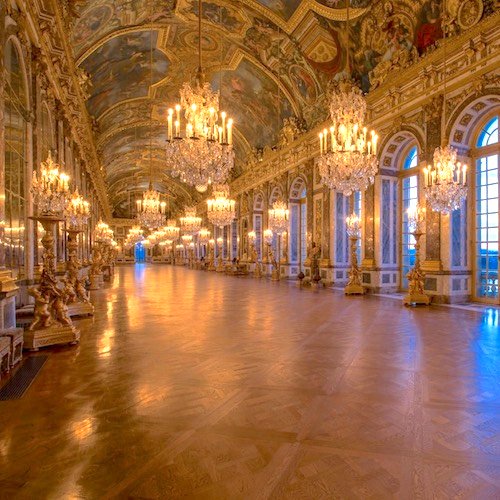 Visiting Versailles
Visiting Versailles |
 Skip the Tower Lines
Skip the Tower Lines |












